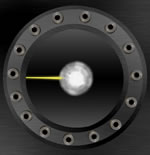
Image credit: NASA
Researchers at Harvard University demonstrated that they can slow light and even completely stop it for several thousandths of a second. They built a chamber containing a cloud of sodium atoms cooled to almost absolute zero and then fired a light pulse into this cloud. The pulse slowed to a stop and even turned off ? the researchers were able to revive it again by firing a laser into the cloud. Although this breakthrough happened a couple of years ago, and an upcoming special edition of Scientific American called ?The Edge of Physics? will provide an update to the research.
NASA-funded research at Harvard University, Cambridge, Mass., that literally stops light in its tracks, may someday lead to breakneck-speed computers that shelter enormous amounts of data from hackers.
The research, conducted by a team led by Dr. Lene Hau, a Harvard physics professor, is one of 12 research projects featured in a special edition of Scientific American entitled “The Edge of Physics,” available through May 31.
In their laboratory, Hau and her colleagues have been able to slow a pulse of light, and even stop it, for several-thousandths of a second. They’ve also created a roadblock for light, where they can shorten a light pulse by factors of a billion.
“This could open up a whole new way to use light, doing things we could only imagine before,” Hau said. “Until now, many technologies have been limited by the speed at which light travels.”
The speed of light is approximately 300,000 kilometers per second (about 186,000 miles per second or 670 million miles per hour). Some substances, like water and diamonds, can slow light to a limited extent. More drastic techniques are needed to dramatically reduce the speed of light. Hau’s team accomplished “light magic” by laser-cooling a cigar-shaped cloud of sodium atoms to one-billionth of a degree above absolute zero, the point where scientists believe no further cooling can occur. Using a powerful electromagnet, the researchers suspended the cloud in an ultra-high vacuum chamber, until it formed a frigid, swamp-like goop of atoms.
When they shot a light pulse into the cloud, it bogged down, slowed dramatically, eventually stopped, and turned off. The scientists later revived the light pulse and restored its normal speed by shooting an additional laser beam into the cloud.
Hau’s cold-atom research began in the mid-1990s, when she put ultra-cold atoms in such cramped quarters they formed a type of matter called a Bose-Einstein condensate. In this state, atoms behave oddly, and traditional laws of physics do not apply. Instead of bouncing off each other like bumper cars, the atoms join together and function as one entity.
The first slow-light breakthrough for Hau and her colleagues came in March 1998. Later that summer, they successfully slowed a light beam to 38 miles per hour, the speed of suburban traffic. That’s 2 million times slower than the speed of light in free space. By tinkering with the system, Hau and her team made light stop completely in the summer of 2000.
These breakthroughs may eventually be used in advanced optical-communication applications. “Light can carry enormous amounts of information through changes in its frequency, phase, intensity or other properties,” Hau said. When the light pulse stops its information is suspended and stored, just as information is stored in the memory of a computer. Light-carrying quantum bits could carry significantly more information than current computer bits. Quantum computers could also be more secure by encrypting information in elaborate codes that could be broken only by using a laser and complex decoding formulas.
Hau’s team is also using slow light as a completely new probe of the very odd properties of Bose-Einstein condensates. For example, with the light roadblock the team created, they can study waves and dramatic rotating-vortex patterns in the condensates.
The Harvard research team includes Hau; Drs. Zachary Dutton, Chien Liu, Brian Busch and Michael Budde; and graduate students Christopher Slowe, Naomi Ginsberg and Cyrus Behroozi. More information about Hau’s research is available on the Internet, at http://www.physics.harvard.edu/fac_staff/hau.html.
For information about NASA’s Fundamental Physics Program on the Internet, visit http://spaceresearch.nasa.gov or http://funphysics.jpl.nasa.gov.
Hau conducts research under NASA’s Fundamental Physics in Physical Sciences Research Program, part of the agency’s Office of Biological and Physical Research, Washington. NASA’s Jet Propulsion Laboratory, Pasadena, Calif., a division of the California Institute of Technology, Pasadena, manages the Fundamental Physics program.
Original Source: NASA News Release
